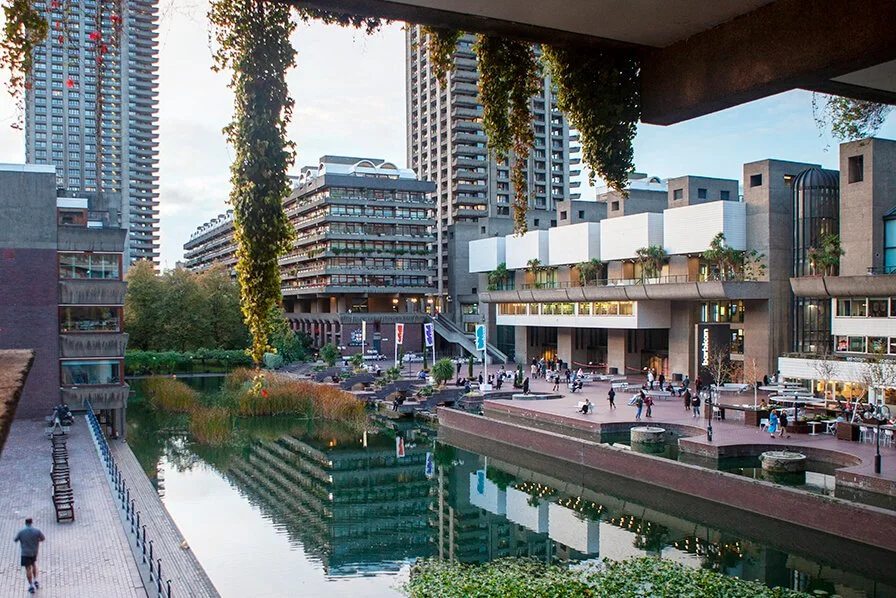DOMstudies: The Barbican Estate
“For most, Brutalism is a miserable danger zone in concrete, but the Barbican reminds us how different it could have been”
- Tom Dixon
This month on the DOMjournal, we are shifting our focus back to our beloved Clerkenwell with a photo essay about the impeccable Barbican Estate by Voytek Ketz. This masterpiece of Brutalist architecture, located just 5 minutes away from The Warehouse, is a perfect example of how great design has people in the heart of it.
In December of 1940, a large portion of the City of London was destroyed in a night of bombing, leaving behind countless homeless in the aftermath of WWII. In an effort to rebuild after the war was over, competitions were organized in the 1950s to propose schemes for social housing, one such being the ground-breaking Golden Lane Estate which marked the first partnership between architects Chamberlin, Powell and Bon. The success of this design was so remarkable, in fact, that their joint practice was almost immediately asked to create a proposal for another site located directly south of their previous project. Unlike its neighbor, however, the Barbican Estate was not intended to become a “council estate” in the conventional sense and instead, flats were to be let out by the Corporation of London to middle-class and upper-middle-class families for commercial rents similar to other private homes in the local market.
Between 1954 and 1968, Chamberlin, Power and Bon proposed four different schemes that offered flats marketed as the perfect homes for affluent people looking for a high-standard architectural experience in the heart of London. Their vision was only focused on rethinking the residencies themselves, but it expanded their intent onto public spaces, which remained uninterrupted by traffic to allow pedestrians to navigate the Estate freely and enjoy a plethora of different perspectives as they crossed over bridges, terraces, gardens and lakes. This separation of vehicle and pedestrian circulation was also facilitated by raising living spaces on a platform and introducing roads and parking spaces in the lower level while positioning access to public transport axes on different sides.
The build started in 1965 and reflects the widespread use of concrete in the UK in the 60s and 70s as the visible face of the facade, being one of London’s principal examples of Brutalist architecture. The three towers and thirteen terrace blocks are interrupted by mews and garden features that punctuate the Brutalist landscape, while community-run green spaces, including a wildlife garden and herb stations are available to residents to this day. The Barbican Estate also contains the Barbican Centre (an arts, drama and business venue), the Barbican public library, the City of London School for Girls, the Museum of London, and the Guildhall School of Music and Drama.
Still to this day one of the most beloved and prestigious residential developments in London, the Barbican, with its integrated flats, shopping, hospitality and culture in one complex with endless possibilities, represents a utopian vision of inner-city living. Over the years, a large number of high-profile residents have made Barbican their home and even nowadays, it’s home to around 4,000 people living in almost 2,000 flats. Under former Minister for the Arts, Tessa Blackstone, the Barbican Estate finally became a Grade II listed building in for its particular architectural and historical interest.
Below is a selection of some of our favorite books about the Barbican which are also available in their shop:
Barbican Centre, 2019
A new title in the Pocket Photo Books series of immersive visual guides to the experience of place, this compact album of more than one hundred photographs by Harry Cory Wright presents the dramatic spaces, rich textures and carefully selected materials of the Barbican Centre in all their detail. From the flowing, multi-level space of the foyer and the calm wooden-panelled concert hall to the surprising intimacy of the theatre and the soaring jungle of the conservatory, the Barbican Centre offers the visitor an extraordinary variety of experiences within a single building. This book captures their full range, providing exceptional insights into one of the most significant and exciting modern buildings in Britain and a thriving cultural hub in the heart of London. With an introduction by Sir Nicholas Kenyon (from Barbican)
Building Utopia: The Barbican Centre, 2022
A beautifully designed celebration of the 40th birthday of the Barbican Arts Centre, in the heart of the City of London. Compiled by Nicholas Kenyon, the Barbican Centre's Managing Director 2007–2021, this is an in-depth exploration of the centre, drawing on the vast array of material available in its archives, much of which has never been seen before. It includes plans and photographs from the centre’s design and construction, original signage and branding, and brochures and programmes. All this is accompanied by a wealth of photographs of the huge range of performances and exhibitions that have taken place over the years, from early RSC performances to the popular Rain Room installation of 2012 to today’s impressive programme of events put together in conjunction with schools and the local community. (from Goodreads)
Residents: Inside the Iconic Barbican Estate, 2016
Anton Rodriguez is a professional photographer and Barbican resident who has combined his passion for both in this stylish photographic publication. Featuring more than 22 Barbican residents and residences, Anton’s work shines a light on the incredible interiors and creative people who live in the iconic Brutalist estate. The book also features an essay by design writer Katie Treggiden, looking at the history of the site and exploring why there is such an interest in seeing ‘behind the scenes’. (from Goodreads)
The Barbican Estate by Stefi Orazi, 2019
Author and designer Stefi Orazi interviews residents past and present, giving an insight into how life on the estate has changed over the decades. This is a beautifully illustrated, comprehensive guide to the estate, with newly commissioned photography by Christoffer Rudquist. It will show in detail each of the 140 different flat types, including newly drawn drawings of the flats as well as original plans and maps. Includes fascinating texts by leading architects and design critics, including John Allan of Avanti Architects on the unique building materials and fittings of the flats, and Charles Holland of Charles Holland Architects (and FAT co-founder) on the home and how these concrete towers have become such an integral part of Britain’s domestic and architectural history (from Goodreads)
Photography by Voytek Ketz















